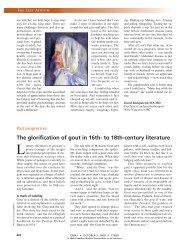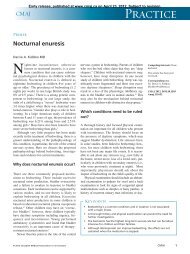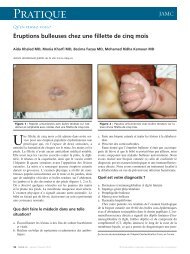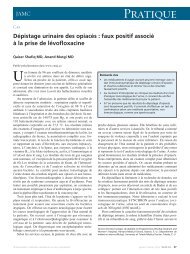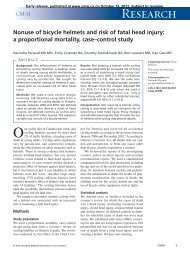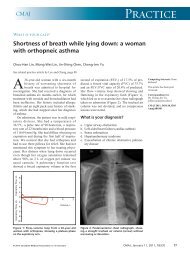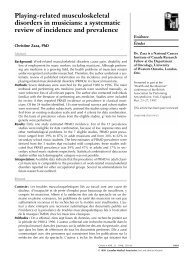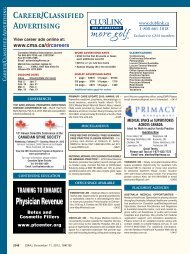Tips for teachers of evidence-based medicine: 1. Relative risk ...
Tips for teachers of evidence-based medicine: 1. Relative risk ...
Tips for teachers of evidence-based medicine: 1. Relative risk ...
Create successful ePaper yourself
Turn your PDF publications into a flip-book with our unique Google optimized e-Paper software.
Barratt et al<br />
pends on the value that patients place on reducing their<br />
<strong>risk</strong> <strong>of</strong> stroke in relation to the increased <strong>risk</strong> <strong>of</strong> gastric<br />
bleeding.<br />
Extension <strong>for</strong> more advanced learners<br />
Explain to the learners that these assessments are only<br />
valid if the relative <strong>risk</strong> reduction associated with the treatment<br />
and the <strong>risk</strong> <strong>of</strong> harm are constant at different levels<br />
<strong>of</strong> <strong>risk</strong> <strong>for</strong> the relevant outcome. This is generally true, 8<br />
and the assumption is helpful in calculating <strong>risk</strong> differences<br />
<strong>for</strong> individuals. 11 However, there are documented examples<br />
<strong>of</strong> relative <strong>risk</strong> varying with baseline <strong>risk</strong>. 12 Encourage the<br />
learners to discuss whether they think that the assumptions<br />
<strong>of</strong> constant relative <strong>risk</strong>s pertaining to benefit <strong>of</strong> therapy<br />
are likely to hold in this example. In the case <strong>of</strong> harm, <strong>risk</strong><br />
differences are likely to be stable and unrelated to the <strong>risk</strong>s<br />
<strong>of</strong> adverse outcomes from the underlying disease.<br />
The bottom line<br />
• Clinicians can tailor trial data to an individual patient<br />
by calculating <strong>risk</strong> differences if they know or can estimate<br />
the individual’s <strong>risk</strong> <strong>of</strong> the relevant outcomes (with<br />
and without treatment).<br />
• Presenting data as <strong>risk</strong> differences makes the benefits<br />
and harms <strong>of</strong> therapy easier to compare.<br />
See Appendix 2 <strong>for</strong> the summary card <strong>for</strong> this tip.<br />
Teaching tip 3: Calculating and using number<br />
needed to treat<br />
When to use this tip<br />
This tip is suitable <strong>for</strong> intermediate-level learners, and the<br />
exercise takes 15–20 minutes. The general objective is to introduce<br />
learners to the calculation and use <strong>of</strong> number needed<br />
to treat (NNT), with the following specific objectives:<br />
• Develop an understanding <strong>of</strong> the concept <strong>of</strong> NNT and<br />
how it is calculated from the <strong>risk</strong> difference.<br />
• Gain familiarity with the concept <strong>of</strong> NNT by comparing<br />
the NNTs that correspond to common interventions.<br />
Number needed to treat: definitions<br />
Number needed to treat: the number <strong>of</strong> patients who<br />
would have to receive the treatment <strong>for</strong> one <strong>of</strong> them to<br />
benefit; calculated as 100 divided by the absolute <strong>risk</strong><br />
reduction expressed as a percentage (or 1 divided by<br />
the absolute <strong>risk</strong> reduction expressed as a proportion;<br />
see Appendix 1)<br />
Number needed to harm: the number <strong>of</strong> patients who<br />
would have to receive the treatment <strong>for</strong> one <strong>of</strong> them to<br />
experience an adverse effect; calculated as 100 divided<br />
by the absolute <strong>risk</strong> increase expressed as a percentage<br />
(or 1 divided by the absolute <strong>risk</strong> increase expressed as<br />
a proportion)<br />
• Learn how to interpret the NNT and develop an understanding<br />
<strong>of</strong> how the “threshold NNT” varies depending<br />
on the patient’s values and preferences, the<br />
severity <strong>of</strong> possible outcomes and the adverse effects<br />
(harms) <strong>of</strong> therapy.<br />
Be<strong>for</strong>e they begin work on NNT, learners must already<br />
be familiar with event rates and <strong>risk</strong> difference. We have<br />
noticed that learners regularly stumble over the calculation<br />
<strong>of</strong> NNT. In particular, they experience confusion over<br />
whether to divide into 100 or into <strong>1.</strong> However, once they<br />
have grasped the concept, many learners find NNT an intuitively<br />
helpful way <strong>of</strong> presenting estimates <strong>of</strong> effect. As a<br />
bonus, this tip <strong>of</strong>fers learners some common values <strong>of</strong><br />
NNTs that can act as reference points <strong>for</strong> the interpretation<br />
<strong>of</strong> other values.<br />
The script<br />
The key to this tip is a table that is built up from learner<br />
contributions and which is then compared with “the truth,”<br />
as reported in published clinical trials. Three populations, interventions<br />
and outcomes <strong>for</strong>m the basis <strong>of</strong> the tip (Table 2).<br />
Start by asking the learners to imagine that a trial has<br />
been per<strong>for</strong>med in connection with each <strong>of</strong> these 3 situations<br />
in which patients con<strong>for</strong>ming to the population as<br />
described have been randomly assigned to receive either<br />
the specified intervention or a placebo. Ask them to guess,<br />
Table 2: Table <strong>of</strong> patients, interventions and outcomes, presented to learners at<br />
outset <strong>of</strong> tip 3<br />
Population Intervention Outcome <strong>of</strong> interest<br />
60-year-old patients with mild hypertension Diuretics Stroke over 5 years<br />
(blood pressure 150/95 mm Hg)<br />
60-year-old patients presenting 1 month after β-Blockers Death over 2 years<br />
myocardial infarction, with no heart failure<br />
60-year-old patients presenting with acute<br />
myocardial infarction Streptokinase Death over 5 weeks<br />
Online-4 JAMC • 17 AOÛT 2004; 171 (4)



